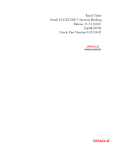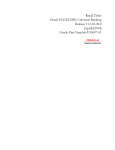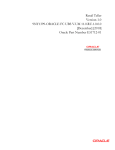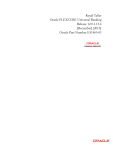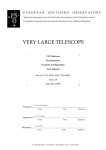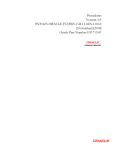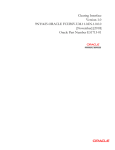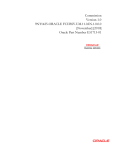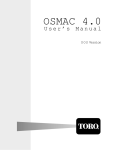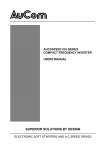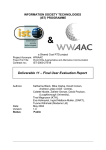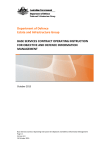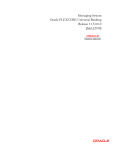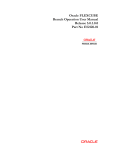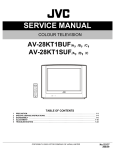Download Retail Teller Version-1.0 9NT1425
Transcript
Retail Teller Version-1.0 9NT1425-ORACLE FCUBSV.UM.11.0.IN.1.0.0.0 [November] [2010] Oracle Part Number E51713-01 Document Control Author: Documentation Team Group: UBPG Created on: October 01, 2008 Revision No: Final Updated by: Documentation Team Reviewed by: Development/Testing teams Approved by: Software Quality Assurance Team Updated on: November 12, 2010 Reviewed on: November 12, 2010 Approved on: November 12, 2010 Retail Teller Table of Contents 1. ABOUT THIS MANUAL................................................................................................................................ 1-1 1.1 1.2 1.3 1.4 1.5 2. RETAIL TELLER MODULE – AN OVERVIEW....................................................................................... 2-1 2.1 3. INTRODUCTION ........................................................................................................................................... 1-1 AUDIENCE .................................................................................................................................................. 1-1 ORGANIZATION .......................................................................................................................................... 1-1 RELATED DOCUMENTS ............................................................................................................................... 1-1 GLOSSARY OF ICONS .................................................................................................................................. 1-2 INTRODUCTION ........................................................................................................................................... 2-1 MAINTAINING RETAIL TELLER PRODUCTS ...................................................................................... 3-1 3.1 INTRODUCTION ........................................................................................................................................... 3-1 3.1.1 Specifying Product Preferences......................................................................................................... 3-2 4. MAINTAINING ACCOUNTING DETAILS................................................................................................ 4-1 4.1 INTRODUCTION ........................................................................................................................................... 4-1 4.1.2 Retail Teller Transaction Input.......................................................................................................... 4-6 4.1.3 Viewing Teller Transactions ............................................................................................................ 4-15 4.1.4 Generation of Advices for Retail Teller Transactions ..................................................................... 4-16 5. ANNEXURE – A.............................................................................................................................................. 5-1 5.1 6. MAPPING ORACLE FLEXCUBE BRANCH FUNCTIONS TO RETAIL TELLER PRODUCTS............................... 5-1 ANNEXURE – B.............................................................................................................................................. 6-1 6.1 DEBIT AND CREDIT ADVICES FOR RETAIL TELLER MODULE ...................................................................... 6-1 6.1.1 Debit Advice Format (Retail Teller Module)..................................................................................... 6-1 6.1.2 Credit Advice Format (Retail Teller Module).................................................................................... 6-2 6.1.3 Accounting Entries for Loan Repayment by Cash: ............................................................................ 6-3 6.1.4 Accounting Entries for Loan Disbursement by Cash:........................................................................ 6-3 7. RETAIL TELLER GLOSSARY.................................................................................................................... 7-1 7.1 LIST OF IMPORTANT TERMS........................................................................................................................ 7-1 1. About this Manual 1.1 Introduction This manual explains the features of the Retail Teller module of Oracle FLEXCUBE which enables you to enter and process retail teller transactions entered through an Oracle FLEXCUBE retail branch. 1.2 Audience This manual is intended for the Customer Service Representatives (CSRs) and staff in charge of setting up new products in your bank. 1.3 Organization This manual is organized as follows: Chapter 1 About this Manual gives information on the intended audience. It also lists the various chapters covered in this User Manual. Chapter 2 The Retail Teller Module – an Overview gives you an overview of the retail teller module. Chapter 3 Maintaining Retail Teller Products describes the procedure to create retail teller products for the specific services your bank offers. Chapter 4 Maintaining Accounting Details explains how to set up accounting details for retail teller products in Oracle FLEXCUBE. Chapter 5 Annexure A lists the inbuilt retail teller products provided for the retail teller module and the association of these products with their appropriate functions in the Retail Branch. Chapter 6 Annexure B contains samples of the various types of advices and notices generated at each stage for the type of contract that the retail teller module handles. Chapter 7 Retail Teller Glossary – gives a list of important terms used in the module. Conventions used in this Manual Important information is preceded with the 1.4 symbol. Related Documents For a detailed description of all the procedures in the manual please refer to the Oracle FLEXCUBE manual on Common Procedures. 1-1 1.5 Glossary of Icons Icons Function New Copy Save Delete Unlock Print Close Re-open Reverse Template Roll-over Hold Authorize Liquidate Exit Sign-off Help Add Delete 1-2 2. Retail Teller Module – An Overview 2.1 Introduction Teller transactions entered through an Oracle FLEXCUBE branch are stored in the Oracle FLEXCUBE database, in the Retail Teller module. The Retail Teller module of Oracle FLEXCUBE provides for the maintenance of appropriate reference information, which would enable entry of teller transactions from an Oracle FLEXCUBE branch, and also enable you to view and enrich transactions that have been entered through an Oracle FLEXCUBE branch. In order to facilitate the entry of teller transactions through the Retail Branch, the following reference information needs to be maintained at the host Oracle FLEXCUBE installation: • Products in the Retail Teller module that would be used to process retail teller transactions entered through the Branch • Accounting and charges details for combinations of product, customer, branch and currency, that will be applicable for retail teller transactions Oracle FLEXCUBE provides inbuilt retail teller products in the Retail Teller module for retail teller transactions entered through an Oracle FLEXCUBE branch. These products are factory shipped, and no new products other than these need be maintained for such retail teller transactions. You can, however, make changes to these inbuilt products, to suit your requirements, and specify any exchange rate parameters and any MIS details. For an exhaustive list of these products and their associations with the corresponding functions in the Oracle FLEXCUBE Retail branch, refer the Annexure –A. The accounting and charges details for combinations of product, customer, branch and currency, that will be applicable for retail teller transactions, must be maintained in the host Oracle FLEXCUBE installation, through the ARC Maintenance. Refer the head ‘Maintaining Accounting Details for Retail Teller Transactions’ in this chapter for information about the ARC Maintenance. 2-1 3. Maintaining Retail Teller Products 3.1 Introduction To process different teller transactions, you must maintain appropriate products. You can maintain products using the ‘RT Product Definition’ screen, which you can invoke from the Application Browser. You can invoke this screen by typing ‘DEDRTPRM’ in the field at the top right corner of the Application tool bar and clicking on the adjoining arrow button. In this screen, you can enter basic information relating to a retail teller product such as the Product Code, the Description, etc. For any product you create in Oracle FLEXCUBE, you can define generic attributes by clicking on the appropriate icon in the horizontal array of icons in this screen. For a retail teller product, in addition to these generic attributes, you can specifically define other attributes. These attributes are discussed in this chapter. You can define the attributes specific to a retail teller product in the RT Product Definition Main screen and the Retail Teller Product Preferences screen. In these screens, you can specify the product type and set the product preferences respectively. 3-1 For further information on the generic attributes that you can define for a product, please refer the Products Oracle FLEXCUBE User Manual. Specifying the Product Type Indicate if the product that you are creating is cash based or non-cash based. From the drop down list in the Product Type field, select ‘Cash’ from the list to indicate a cash type product, or select ‘Others’ to indicate a non-cash type product. 3.1.1 Specifying Product Preferences You can maintain preferences for teller products from the Product Definition Main screen. Click ‘Preferences’ button to invoke the ‘Retail Teller Product Preferences’ screen. Track Receivable During liquidation of teller transactions, if the system detects insufficient funds in the account, then you can choose to block the subsequent credit that happens to the settlement account. In other words, the system will track the account for receivables. As and when a credit happens, the funds will be allocated to the teller entry depending on the product sequence that you specify at the account class level. 3-2 Refer to the Core Entity User Manual for details on maintaining funds allocation sequence. When you post a teller transaction to an account and there are insufficient funds in the account, then the system will save the contract but the contract remains uninitiated. Accounting entries will not be posted for this contract. During EOD processing of these contracts, when the full balance becomes available in the account, the system will post the necessary accounting entries and mark the contract as liquidated. Your specification for this field will default to all contracts involving the product. However, you are allowed to modify it at the contract level also. Retail Lending Product Check this option to allow a retail lending loan account in the transaction. Only products marked as ‘Retail Lending Product’ will allow a retail lending loan account in the transaction. PC Transaction Check this box to generate the PC transaction for the branch transaction under the RT product. Denomination tracking required Check this box to identify whether the denomination details needs to be captured or not for the RT product. Till Required Check this box to identify whether the Till update required or not for the RT product. Tax detail limit currency Specify the currency for threshold amount. Tax details limit Specify the threshold amount. Mandatory Tax details field Specify the field mandatory for the transaction. The limit needs to be left blank if the preference is not applicable for certain products .For online screens, the validation is enforced, only if the amount exceeds. 3-3 4. Maintaining Accounting Details 4.1 Introduction After you have maintained the requisite products for retail teller transactions, you must maintain the accounting information that will be used by the system to process such transactions involving the product. In the Account, Rates and Charges (ARC) screen, you can maintain accounting information that will be used to • Identify the transaction account and offset account to which accounting entries arising from a retail teller transaction using the product will be posted • Identify whether the offset account or the transaction account must be considered to be the debit account in a retail teller transaction using the product • Identify whether any applicable charges in a retail teller transaction using the product must be paid out from the offset account or the transaction account • Compute the applicable charges that would be levied • Identify the transaction codes to be used for the accounting entries In the ARC Maintenance screen, you maintain accounting and charges information that would be applicable for processing retail teller transactions involving a specific branch, retail teller product and specific currency combination. You can invoke the ‘ARC Maintenance’ screen from the application browser. You can invoke this screen by typing ‘IFDATMMN’ in the field at the top right corner of the Application tool bar and clicking on the adjoining arrow button. In the ARC Maintenance screen, you maintain accounting and charges information (known as ARC details) that would be applicable when processing retail teller transactions involving a specific branch, retail teller product and specific currency combination. 4-1 It is recommended that you maintain ARC details for all possible combinations of retail teller branch, product, offset currency, transaction currencies, customer and customer group. If you do not maintain specific records for each currency, customer and branch combination, you can use the ‘*.* ‘ option. Product Type While maintaining the ARC details, you have to indicate the retail teller product, transactions involving which the details would apply. Each product in Oracle FLEXCUBE is identified with a unique four character alphanumeric code. You can indicate the appropriate product. It is recommended that you maintain ARC details to be applicable for each retail teller product that you set up. Currency You must indicate the currency, transactions involving which the ARC details would be applied. For each currency in which retail teller transactions would be processed involving the selected product, you can maintain a separate set of ARC details in this screen. You can also choose the “ALL” option under currency, which the system, will use if no specific record for a currency is available. 4.1.1.1 Identifying Offset Account You can specify the offset account or GL into which offset entries are to be booked, as a result of the teller transaction involving the product, branch and currency. You can also indicate the branch in which the offset account resides. You can also choose the “ALL” option, which the system interprets as the branch in which the transaction is being input. Indicating the offset account as the debit account You could indicate that the offset account is to be the debit account for the transaction, in teller transactions involving the product, branch and currency combination. To indicate this, select the ‘Offset Account’ option in the Debit Account field on this screen. Indicating the offset account as the default charge account You could indicate that the offset account is to be the default charge account for the transaction, in teller transactions involving the product, branch and currency combination. This means that the charges would be recovered from this account. To indicate this, select the ‘Offset Account’ option in the Charge From Account field on this screen. If the offset account you have specified uses an account class that is restricted for debit or credit transactions for the product, an override is sought when you attempt to save the contract. 4.1.1.2 Identifying Transaction Account You must specify the transaction account for the retail teller transaction, as well as the branch in which this account resides. The branch information you specify here could also be used in the case of an inter-branch transaction. If you wish to maintain ARC details for a specific customer, you can specify a valid customer account here. In such a case, the ARC record will be applicable to all retail teller transactions involving the customer, product, branch and currency combination that you have specified in this record, in this screen. 4-2 Indicating the transaction account as the debit account You could indicate that the transaction account is to be the debit account for the transaction, in teller transactions involving the product, branch and currency combination. To indicate this, select the ‘Transaction Account’ option in the Debit Account field on this screen. Indicating the transaction account as the default charge account You could indicate that the transaction account is to be the default charge account for the transaction, in teller transactions involving the product, branch and currency combination. This means that the charges would be recovered from this account. To indicate this, select the ‘Transaction Account’ option in the Charge From Account field on this screen. Typically for a “Cash Deposit” type of a transaction, in which the customer account will be specified when the transaction is entered, the same account would also be used to debit the charges. If the transaction account you have specified uses an account class that is restricted for debit or credit transactions for the product, an override is sought when you attempt to save the contract. 4.1.1.3 Identifying Offset and Debit Transaction Codes In addition, you have to also identify the transaction codes against which offset and debit related entries for the transaction ought to be tracked. For instrument-based products (such as check deposit / check withdrawal products) you must ensure that you specify a transaction code for which check numbers are mandatory. Generate Transaction Advices You can indicate that advices must be generated for retail teller transactions involving the product, branch and currency combination. The advice types that are available for the Retail Teller module are the debit and credit advices generated for the debit or credit entries that would be passed to customer accounts, namely, “DR ADVICE” and “CR ADVICE”. For further information on the debit and credit advices, please refer the Annexure –B. Netting Charge You have the option to net the accounting entries for the debit leg of the charges along with the main transaction entries. Check this box to indicate that the debit leg of the charges is to be netted before passing the accounting entries. Leave the box unchecked to pass the entries without netting the charges of the debit leg. End Point In case of Outward Clearing, Clearing House is derived based on the End Point maintained for the ARC combination. Description End Point Description (Display Only field). 4-3 Bank Float Days In case Bank Float Days is not maintained at the Clearing Bank/Branch level, it is picked up from here. Customer Float Days In case Customer Float Days is not maintained at the Clearing Bank/Branch level, it is picked up from here. Float Days Basis Whether to consider the Calendar Days or Working Days for computing the Value Date based on the Floats maintained. 4.1.1.4 Defining Charge Details You can define a maximum of five charges. A charge can be computed based either on the transaction amount or on an earlier charge amount As part of defining the Charge details for each charge, you need to capture the following details in the corresponding charge tabs: Charge Type The Charge Type that should be applied on the transaction. It could either be a Percentage of the transaction amount or a Flat Charge. Slab type Select whether the Charge computation has to be over different Amount Slabs or Tiers (0-100 @ 10, 101-500 @ 15 etc.). Basis You can indicate the basis amount on which the charge is to be computed. Since you can maintain five different charge amounts, the basis amount that you enter could either be the transaction amount or any of the earlier charge amounts. For example, let us assume you are maintaining Charge 1. The only basis for charge 1 can be the transaction amount. While defining Charge 2 you can choose either the transaction amount or Charge 1 as the basis. Similarly while defining Charge 3, you can choose the transaction amount or Charge 1 or Charge 2 as the basis. Currency You can indicate the currency in which the charge amount would be expressed. If the transaction currency is different from the charge currency, a conversion would be done, using the rate code and rate type that you specify for each charge. Charge Account You can specify the charge account (income / expense account) into which charge related entries are to be posted. The other leg of the charge is posted either to the transaction or the offset account, as specified in the ARC record. 4-4 Netting If two or more accounting entries, for the same event, are to be passed to the same account, on the same Transaction Date, these entries can be netted. You can choose to net the charge leg of the Transaction Account (debit) entry with the main leg of the customer accounting entry. Transaction Code You can indicate the code using which the accounting entries would be booked, for each charge. Rate Code and Rate Type While settling charges for cross currency transactions, you can choose to debit the customer by applying the mid rate, buy rate or by using the buy/sell spread over the mid-rate. Therefore you need to specify the Exchange Rate details for each ARC definition record that you maintain in the system. Firstly, indicate the Rate Code for which different rates can be maintained. A list of all the rate codes maintained in the Floating Rates Maintenance screen is displayed in the list. You can choose the appropriate code. In addition to specifying the Rate Code you have to indicate the Rate Type which should be picked up for exchange rate conversions involving settlement of charges for cross currency transactions. You can maintain any one of the following as the Rate Type: • Buy • Mid • Sell After identifying the Rate Code and Rate Type you can indicate the basis amount on which charges are to be computed. Amount You have to specify the flat amount only when the charge type is a Flat Amount. The flat amount will be collected in the currency that you have specified in the Currency Code field. Rate If you have indicated that the charge should be a percentage of the transaction amount, you have to necessarily capture the rate that is to be applied on the transaction amount. The rate that you specify will be applied after converting the amount into the Account Currency. Interest Basis Interest Computation basis (360 days, 365 days etc.). Minimum and Maximum Charge Amount When the charge type applicable on the transaction is a percentage of the transaction amount you have to capture the minimum and maximum charge amounts that should be applied on the transaction. 4-5 If the charge percentage involving a particular transaction is less than the minimum charge the system will by default debit the customer account with the minimum charge amount. Similarly, when the charge percentage exceeds the maximum amount, the system will debit the customer account with the maximum charge amount. The charge amount will be deducted in the currency that you specified earlier. MIS Head Specify the MIS Head that is applicable for the charge-related accounting entry. Description You can indicate a short description for the charge. 4.1.2 Retail Teller Transaction Input You can invoke the retail teller transactions in the Retail Teller Maintenance screen. Invoke this screen from the application browser, or fast path 1000. You can capture the PC related details from this screen, to trigger a NEFT / RTGS payment transaction, to other bank, using a cash deposit. External Reference Number The system generates a unique number based on the branch-specific sequence number generation logic and displays it here. The Host system identifies a branch transaction with the external reference number. 4-6 Product The system displays the code of the retail teller product maintained in the system that will be used for processing the transaction. Transaction Branch Specify the branch where the customer account into which retail teller transaction is processed. Transaction Currency Specify the currency in which the retail teller transaction is processed. You can select the appropriate code from the adjoining option list that displays all the currency codes maintained in the system. Click save icon to go to the next stage. Enrichment stage On clicking save icon, the system validates and ensures for minimum mandatory data entry. If the data entry is found alright, it will calculate the charge based on the transaction type. The following screen will be displayed: In addition to the details, captured in the previous stage, the system defaults the following details: 4-7 Transaction Account Number Specify the customer account into which retail teller transaction is processed. The adjoining option list displays all the accounts maintained in the system. You can select the appropriate account number. Transaction Amount Specify the amount that should be credited to the account in the specified currency Tax ID Specify a valid tax ID for retail teller transaction input. Tax Detail 1 Specify details of the tax for retail teller transaction input. You can specify details of source funds or the reason for the deposit. Offset Branch Specify a valid offset branch from the adjoining option list. Offset Account Specify a valid offset account from the adjoining option list. Offset currency Specify a valid offset currency from the adjoining option list. Offset Amount Specify a valid offset amount. Click save icon to go to the next stage. Enrichment stage On clicking save icon, the system validates and ensures for minimum mandatory data entry. If the data entry is found alright, it will calculate the charge based on the transaction type. The following screen will be displayed: 4-8 In addition to the details, captured in the previous stage, the system defaults the following details: Branch Code Branch code of the current branch is defaulted here. Exchange Rate The system displays the exchange rate used to convert the transaction currency into account currency. If the transaction currency is the same as the account currency, the system will display the exchange rate as ‘1’. Related Customer Specify a valid customer related to the transaction from the adjoining option list. 4.1.2.1 Charges Tab You can maintain charges for teller transactions from the Retail Teller Transaction Input screen. Click ‘Charges’ tab to invoke Charge Details. 4-9 You can maintain the following charge details here: Charge Components Specify a valid charge component for teller transaction, from the adjoining option list. Waiver Specify waiver for teller transaction. Charge Amount Specify a valid charge amount for teller transaction. Currency Currency of the teller transaction is defaulted here from the main screen. Charge in Local Currency Charge of the teller transaction in LCYis defaulted here based on the details maintained in the main screen Exchange Rate Exchange rate of the teller transaction is defaulted here from the main screen 4-10 4.1.2.2 UDF Tab You can maintain UDF details for teller transactions from the Retail Teller Transaction Input screen. Click ‘Charges’ tab to invoke UDF Details. 4.1.2.3 PC Details Tab You can maintain PC details for teller transactions from the Retail Teller Transaction Input screen. Click ‘PC Details’ tab to invoke ‘PC Details’. 4-11 Specify the following details under the PC details: Counterparty Name Specify the name of the counter party to whom the payment message has to be sent. Counterparty Address 1 Specify the first address of the counterparty. Counterparty Address 2 Specify the second address of the counterparty. Counterparty Address 3 Specify the third address of the counterparty. Counterparty Bank Code Select the counterparty bank code from the list of options provided. Counterparty Account Number Specify the external counter party account number. 4-12 Counterparty Account Type Select the counterparty account type from the following values in drop down list: • Savings Bank • Current Account • Overdraft • Cash Credit • Loan Account • NRE • Cash • Indo Nepal • Credit Card Sender Receiver Information1 Specify the first sender receiver information. Sender Receiver Information2 Specify the second sender receiver information. Sender Receiver Information3 Specify the third sender receiver information. Clearing Network Select the clearing network NEFT / RTGS, from the list of options provided. Customer Name Specify the customer name, in case of walk-in customer. (System defaults the customer name of the transaction account if transaction account is entered) Customer Address 1 Specify the first address of the customer. (System defaults the customer address of the transaction account if entered) Customer Address 2 Specify the second address of the customer. (System defaults the customer address of the transaction account if entered) Customer Address 3 Specify the third address of the customer. (System defaults the customer address of the transaction account if entered) Communication Mode Specify the mode of the communication for intimation about the beneficiary account credit 4-13 Mobile Number Specify the mobile number. (System defaults the mobile number of the transaction account if entered) Email ID Specify the e-mail -id. (System defaults the email-id of the transaction account if entered). Note the following: • These fields are applicable only if the ‘PC Transaction’ flag is checked for RT products. • The denomination tab captures the denomination details for the RT product only if the ‘Denomination Tracking Required’ flag is checked for that RT product. • On authorization of this transaction system automatically creates the outgoing payment transaction in PC module for the amount of (Transaction amount – Total Charges). After this process, any operations on branch transaction or outgoing payment transaction are handled independently. For further information on the mapping of PC product category with RT Module, please refer Payments and Collections Maintenance chapter in Payments and Collections module. 4.1.2.4 Denomination Tab You can maintain Denomination for teller transactions from the Retail Teller Transaction Input screen. Click ‘Denomination’ tab to invoke Denomination Details. 4-14 You can maintain the following charge details here: Denomination Code Denominationc of teller transaction is defaulted here. Denomination Value Specify denomination valuefor teller transaction. Units Specify a valid unit for teller transaction. Total Amount Specify total amount of teller transaction. 4.1.3 Viewing Teller Transactions You can view retail teller transactions in the ‘Retail Teller Transaction Query’ screen. Invoke this screen from the application browser. You can invoke this screen by typing ‘DEDQUERY’ in the field at the top right corner of the Application tool bar and clicking on the adjoining arrow button. In this screen, you can view the following details for each teller transaction: • Product • Related Customer • User Reference Number • Reference Number • Tanked Transaction 4-15 Tax ID Tax ID for retail teller transaction is defaulted here based on the details maintained at transaction level. Tax Detail 1 Tax details for retail teller transaction is defaulted here based on the details maintained at transaction level. For more information on Tanked Transaction, refer Branch Parameters chapter under Core Services module. 4.1.3.1 Viewing Transaction Leg Details Here you can view the following details: • Transaction Currency • Transaction Branch • Transaction Account • Transaction Amount • Transaction Code 4.1.3.2 Specifying Offset Leg Details • Offset Currency • Offset Account Branch • Offset Account • Offset Amount • Transaction Code 4.1.3.3 Viewing Instrument Codes You can view the following details here. • Value Date • Exchange Rate • Local Currency Exchange Rate • Local Currency Amount • Narrative • Track Receivable 4.1.4 Generation of Advices for Retail Teller Transactions As mentioned earlier, the system generates debit / credit advices if so specified in the ARC Maintenance record for the product, currency and branch combination involving the transaction. For an ODC transaction, payment and cover messages are generated based on the route code specified. The formats for the same are given in the Annexure –B. 4-16 5. Annexure – A Mapping Oracle FLEXCUBE Branch Functions to Retail Teller Products 5.1 Oracle FLEXCUBE provides inbuilt retail teller products in the Retail Teller module for retail teller transactions entered through a Oracle FLEXCUBE branch. These products are factory shipped, and no new products other than these need be maintained for such retail teller transactions. You can, however, make changes to these inbuilt products, to suit your requirements, and specify any exchange rate parameters and any MIS details. An exhaustive list of these products and their associations with the corresponding functions in the Oracle FLEXCUBE branch are given below. Branch Transaction Fast Path Function Description Retail Teller Module Product Code 1001 Cash Withdrawal CHWL 1009 TC Sale (Against A/C) TCSN 1013 Check Withdrawal CQWL 1060 Miscellaneous GL Debit MGLD 1401 Cash Deposit CHDP 1409 TC Purchase (Against A/C) TCPN 1460 Miscellaneous GL Credit MGLC 8205 TC Sale (Against GL) TCSG 9009 Buy Cash From Central Bank BCCB 9010 Sell Cash To Central Bank SCCB 9011 Buy TCs From AGENT BTAG 9015 Buy TCs from HO BTHO 9016 Sell TCs from HO STHO 1005 Miscellaneous GL Transfer MSGL 1006 Funds Transfer Request FTRQ 1008 Miscellaneous Customer Debit MSCD 1015 Funds Transfer Request- FTNT 5-1 Branch Transaction Fast Path Function Description Retail Teller Module Product Code NoCOT 1018 Miscellaneous Customer Debit-NoCOT CDNT 1408 Miscellaneous Customer Credit MSCC 8301 BC Issue Walk-In BCIW 8302 BC Issue Against GL BCIG 8305 DD Issue Walk-In DDIW 8306 DD Issue against GL DDIG 8307 BC Liquidation Walk-In BCLW 8308 BC Liquidation Against GL BCLG 8309 BC Liquidation Against Account BCLA 8310 DD Liquidation Walk-In DDLW 8311 DD Liquidation against GL DDLG 8312 DD Liquidation Against Account DDLA 1010 BC Sale against Account BCSA 1014 DD Sale against Account DDSA 8003 TC Purchase (Walk-In) TCPW 8004 FX Purchase (Walk-in) FXPW 8203 FX Sale (Walk-in) FXSW 8204 TC Sale (Walk-In) TCSW 7551 Book Shortage BKSG 7552 Book Overage BKOG 1300 Close Out Withdrawal by Bankers Cheque CWBC 1301 Close Out Withdrawal COWL 5-2 Branch Transaction Fast Path Function Description Retail Teller Module Product Code 1320 Close Out Withdrawal FTRQ 8301 BC Issue Walk-In BCIW 8302 BC Issue Against GL BCIG 8305 DD Issue Walk-In DDIW 8306 DD Issue against GL DDIG 8311 DD Liquidation against GL DDLG 8312 DD Liquidation Against Account DDLA 5001 Manual Loan Disbursement by Cash LDCH 5401 Manual Loan Repayment by Cash LRCH 5-3 6. Annexure – B 6.1 Debit and Credit Advices for Retail Teller Module The advice types that are available for the Retail Teller module are the debit and credit advices generated for the debit or credit entries that would be passed to customer accounts, namely, “DR ADVICE” and “CR ADVICE”. The formats for these advices are given below. 6.1.1 Debit Advice Format (Retail Teller Module) #RH DEBIT ADVICE DATE: _BRN-DATE_ PAGE: _PG_ #SC _CUSTOMER-NAME_ _CUSTADDR1_ _CUSTADDR2_ _CUSTADDR3_ _CUSTADDR4_ #EC #EH #PH PAGE: _PG_ #EH #B CUSTOMER ID: _CUSTOMER_ ACCOUNT No: _ACCOUNT_ OUR REFERENCE NO: _CONTRACTREFNO_ USER REFERENCE NO: _USERREFNO_ WE HAVE EXECUTED THE FOLLOWING TRANSACTION ON YOUR BEHALF ON ------------------------------------------------------------------VALUE DATE CCY AMOUNT ------------------------------------------------------------------_VALDT_ _CCY_ _AMOUNT_ ------------------------------------------------------------------- 6-1 _TRNDT_: DETAILS OF CHARGES FOR THE ABOVE TXN ARE: CHARGE AMOUNT 1: _CHGAMT1_ -CHGCCY1_ CHARGE AMOUNT 2: _CHGAMT2_ -CHGCCY2_ CHARGE AMOUNT 3: _CHGAMT3_ -CHGCCY3_ CHARGE AMOUNT 4: _CHGAMT4_ -CHGCCY4_ CHARGE AMOUNT 5: _CHGAMT5_ -CHGCCY5_ THE ACCOUNT BALANCE AFTER THE TXN IS: _ACCBAL_ #EB #RF AUTHORIZED SIGNATORY #EF 6.1.2 Credit Advice Format (Retail Teller Module) #RH CREDIT ADVICE DATE: _BRN-DATE_ PAGE: _PG_ #SC _CUSTOMER-NAME_ _CUSTADDR1_ _CUSTADDR2_ _CUSTADDR3_ _CUSTADDR4_ #EC #EH #PH PAGE: _PG_ #EH #B CUSTOMER ID ACCOUNT : _CUSTOMER_ : _ACCOUNT_ 6-2 OUR REFERENCE NO : _CONTRACTREFNO_ USER REFERENCE NO : _USERREFNO_ WE HAVE EXECUTED THE FOLLOWING TRANSACTION ON YOUR BEHALF: ------------------------------------------------------------------VALUE DATE CCY AMOUNT ------------------------------------------------------------------_VALDT_ _CCY_ _AMOUNT_ ------------------------------------------------------------------#EB #RF AUTHORIZED SIGNATORY #EF 6.1.3 Accounting Entries for Loan Repayment by Cash: Following are the accounting entries passed for the manual repayment of loan by cash: EVENT Dr/Cr ACCOUNTING ROLE AMOUNT TAG INIT Dr OFFSET_ACCOUNT(The GL for Cash) OFS_AMT INIT Cr DR_SETTL_BRIDGE TXN_AMT 6.1.4 Accounting Entries for Loan Disbursement by Cash: Following are the accounting entries passed for the manual repayment of loan by cash: EVENT Dr/Cr ACCOUNTING ROLE AMOUNT TAG INIT Dr CR_SETTL_BRIDGE TXN_AMT Cr OFFSET_ACCOUNT(The GL for Cash) OFS_AMT INIT 6-3 7. Retail Teller Glossary 7.1 List of Important Terms This section gives a list of important terms used in this manual. Account Statement This specification indicates whether the transaction (posted using data entry module) must be made available while the statement for the account is generated. Amount Item This indicates the amount entry that is passed into a general ledger / sub ledger in the chart of accounts for each transaction. Authorization A facility provided for the purpose of cross-checking and verifying a transaction to ensure that it conforms to the parameters maintained for the branch. After authorization, the transaction comes into effect and will be processed by the system. Authorization Amount Limit This indicates the maximum amount of a transaction that can be authorized by an authorizer user in the system. Authorizer This indicates a user who authorizes maintenance information records or transactions in Oracle FLEXCUBE. The authorizer cannot be the same user who created the record. Batch This indicates a group of transactions of a particular type. All transactions of a particular type can be authorized on a business day by authorizing the batch into which they have been grouped. Branch Parameters Static information maintained for a branch, containing mandatory operations and default parameters that would be specific to the branch. They are also known as branch conditions. Clearing Bank Codes This indicates unique identifiers maintained in Oracle FLEXCUBE for banks that are participants in a clearing house. Currency Denominations This indicates discrete lots in which paper currency is available. Each lot may contain one or more units of currency. Customer Category This indicates a group of customers with logically similar features or attributes. 7-1 Default Charge Collection Account The account to which the charges for the transaction will be charged. This account can be defined at the product level as “Transaction” account or “Offset” account. Denomination Tracking This indicates tracking currency denominations for teller type transactions at a branch. Exchange Rate Type This indicates the type of exchange rate that you can specify for a product. Exchange Rate Variance This indicates the difference between the default value and the changed value of an exchange rate employed for currency conversion. Limits can be set for the variance. Maximum Variance This indicates the limit beyond which an exchange rate cannot be changed over and above the default value and an override is not possible. MIS Code This indicates a unique grouping of MIS (Management Information System) details such as Transaction MIS, Composite MIS, Cost MIS and so on, maintained for management reporting purposes. Normal Variance This indicates the limit within which exchange rates are allowed to be changed over and above the default value, without requiring an override. This limit corresponds to the minimum variance. Overdraft This indicates the amount by which an account has been overdrawn. Product This indicates an identifier, in Oracle FLEXCUBE, for any type of service that a bank offers its customers. It represents a set of attributes and preferences are maintained for the product, which will apply to the processing of any contracts, transactions or deals involving the product (service). Shortage/Overage GL This indicates the general ledger used for posting accounting entries related to differences between actual transaction amounts and amounts available in denominations. Signature Verification This indicates the process of authentication of a customer’s signature. It is typically enforced for transactions involving amounts exceeding a certain specified limit. Teller Till Balancing This indicates the task of reconciling the physical balance in a till with the balance according to the system records. The operator performs this activity during the Beginning of Day process. 7-2 Teller Type Transaction This indicates the transaction performed by a teller. Cash deposits and withdrawals, sale and purchase of traveler checks and clearing checks are all teller type transactions. Till A cash register used by a teller for the purpose of disbursing withdrawals and receiving deposits. A till is usually linked to a safe or a vault. Transaction Account This indicates the account of the customer involved in a transaction. For transactions in respect of which internal entries are passed, it could also be a general ledger. Transaction Amount Limit This is the maximum and minimum limits which represent the allowable range for the amount of a transaction. Transaction Codes These indicate unique identifiers maintained in Oracle FLEXCUBE for different types of cash transfers (transactions) within the branch. A transaction code is also an identifier for each accounting entry that describes the nature (i.e., debit or credit) of the entry. Transaction Limits These are limits placed on the size of a transaction that a teller is allowed to input. Vault This is a safe where the physical cash assets of a bank (or branch) are kept. A bank may maintain one or more vaults. 7-3 Retail Teller [November] [2010] Version 1.0 Oracle Corporation World Headquarters 500 Oracle Parkway Redwood Shores, CA 94065 U.S.A. Worldwide Inquiries: Phone: +1.650.506.7000 Fax: +1.650.506.7200 www.oracle.com/ financial_services/ Copyright © [2010] Oracle Financial Services Software Limited. All rights reserved. No part of this work may be reproduced, stored in a retrieval system, adopted or transmitted in any form or by any means, electronic, mechanical, photographic, graphic, optic recording or otherwise, translated in any language or computer language, without the prior written permission of Oracle Financial Services Software Limited. Due care has been taken to make this document and accompanying software package as accurate as possible. However, Oracle Financial Services Software Limited makes no representation or warranties with respect to the contents hereof and shall not be responsible for any loss or damage caused to the user by the direct or indirect use of this document and the accompanying Software System. Furthermore, Oracle Financial Services Software Limited reserves the right to alter, modify or otherwise change in any manner the content hereof, without obligation of Oracle Financial Services Software Limited to notify any person of such revision or changes. All company and product names are trademarks of the respective companies with which they are associated.





































